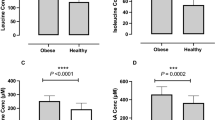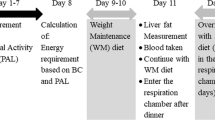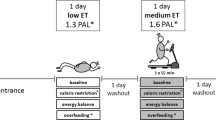Abstract
Background/objectives:
Because both, glycemic index (GI) and carbohydrate content of the diet increase insulin levels and could thus impair fat oxidation, we hypothesized that refeeding a low GI, moderate-carbohydrate diet facilitates weight maintenance.
Subjects/methods:
Healthy men (n=32, age 26.0±3.9 years; BMI 23.4±2.0 kg/m2) followed 1 week of controlled overfeeding, 3 weeks of caloric restriction and 2 weeks of hypercaloric refeeding (+50, −50 and +50% energy requirement) with low vs high GI (41 vs 74) and moderate vs high CHO intake (50% vs 65% energy). We measured adaptation of fasting macronutrient oxidation and the capacity to supress fat oxidation during an oral glucose tolerance test. Changes in fat mass were measured by quantitative magnetic resonance.
Results:
During overfeeding, participants gained 1.9±1.2 kg body weight, followed by a weight loss of −6.3±0.6 kg and weight regain of 2.8±1.0 kg. Subjects with 65% CHO gained more body weight compared with 50% CHO diet (P<0.05) particularly with HGI meals (P<0.01). Refeeding a high-GI diet led to an impaired basal fat oxidation when compared with a low-GI diet (P<0.02), especially at 65% CHO intake. Postprandial metabolic flexibility was unaffected by refeeding at 50% CHO but clearly impaired by 65% CHO diet (P<0.05). Impairment in fasting fat oxidation was associated with regain in fat mass (r=0.43, P<0.05) and body weight (r=0.35; P=0.051).
Conclusions:
Both higher GI and higher carbohydrate content affect substrate oxidation and thus the regain in body weight in healthy men. These results argue in favor of a lower glycemic load diet for weight maintenance after weight loss.
This is a preview of subscription content, access via your institution
Access options
Subscribe to this journal
Receive 12 print issues and online access
$259.00 per year
only $21.58 per issue
Buy this article
- Purchase on Springer Link
- Instant access to full article PDF
Prices may be subject to local taxes which are calculated during checkout



Similar content being viewed by others
References
Abbott WG, Howard BV, Christin L, Freymond D, Lillioja S, Boyce VL et al. Short-term energy balance: relationship with protein, carbohydrate, and fat balances. Am J Physiol 1988; 255: E332–E337.
Swinburn B, Ravussin E . Energy balance or fat balance? Am J Clin Nutr 1993; 57: 766S–770S, discussion 770S-771S.
Hill JO, Peters JC, Reed GW, Schlundt DG, Sharp T, Greene HL . Nutrient balance in humans: effects of diet composition. Am J Clin Nutr 1991; 54: 10–17.
Weyer C, Pratley RE, Salbe AD, Bogardus C, Ravussin E, Tataranni PA . Energy expenditure, fat oxidation, and body weight regulation: a study of metabolic adaptation to long-term weight change. J Clin Endocrinol Metab 2000; 85: 1087–1094.
Pannacciulli N, Salbe AD, Ortega E, Venti CA, Bogardus C, Krakoff J . The 24-h carbohydrate oxidation rate in a human respiratory chamber predicts ad libitum food intake. Am J Clin Nutr 2007; 86: 625–632.
Zurlo F, Lillioja S, Esposito-Del Puente A, Nyomba BL, Raz I, Saad MF et al. Low ratio of fat to carbohydrate oxidation as predictor of weight gain: study of 24-h RQ. Am J Physiol 1990; 259: E650–E657.
Ellis AC, Hyatt TC, Hunter GR, Gower BA . Respiratory quotient predicts fat mass gain in premenopausal women. Obesity (Silver Spring) 2010; 18: 2255–2259.
Galgani J, Ravussin E . Energy metabolism, fuel selection and body weight regulation. Int J Obes 2008; 32: 109–119.
Kelley DE, Goodpaster B, Wing RR, Simoneau JA . Skeletal muscle fatty acid metabolism in association with insulin resistance, obesity, and weight loss. Am J Physiol 1999; 277: E1130–E1141.
Jebb SA, Prentice AM, Goldberg GR, Murgatroyd PR, Black AE, Coward WA . Changes in macronutrient balance during over- and underfeeding assessed by 12-d continuous whole-body calorimetry. Am J Clin Nutr 1996; 64: 259–266.
Isken F, Klaus S, Petzke KJ, Loddenkemper C, Pfeiffer AF, Weickert MO . Impairment of fat oxidation under high- vs low-glycemic index diet occurs before the development of an obese phenotype. Am J Physiol Endocrinol Metab 2010; 298: E287–E295.
Pawlak DB, Kushner JA, Ludwig DS . Effects of dietary glycaemic index on adiposity, glucose homoeostasis, and plasma lipids in animals. Lancet 2004; 364: 778–785.
Clapp JF, Lopez B . Low-versus high-glycemic index diets in women: effects on caloric requirement, substrate utilization and insulin sensitivity. Metab Syndr Relat Disord 2007; 5: 231–242.
Díaz EO, Galgani JE, Aguirre CA, Atwater IJ, Burrows R . Effect of glycemic index on whole-body substrate oxidation in obese women. Int J Obes (Lond) 2005; 29: 108–114.
Díaz EO, Galgani JE, Aguirre CA . Glycaemic index effects on fuel partitioning in humans. Obes Rev 2006; 7: 219–226.
Tremblay A, Boulé N, Doucet E, Woods SC . Is the insulin resistance syndrome the price to be paid to achieve body weight stability? Int J Obes (London) 2005; 29: 1295–1298.
MacLean PS, Higgins JA, Jackman MR, Johnson GC, Fleming-Elder BK, Wyatt HR et al. Peripheral metabolic responses to prolonged weight reduction that promote rapid, efficient regain in obesity-prone rats. Am J Physiol Regul Integr Comp Physiol 2006; 290: R1577–R1588.
Jackman MR, Steig A, Higgins JA, Johnson GC, Fleming-Elder BK, Bessesen DH et al. Weight regain after sustained weight reduction is accompanied by suppressed oxidation of dietary fat and adipocyte hyperplasia. Am J. Physiol Regul Integr Comp Physiol 2008; 294: 1117–1129.
Meinert Larsen T, Dalskov SM, van Baak M, Jebb SA, Papadaki A, Pfeiffer AFH et al. Diets with high or low protein content and glycemic index for weight-loss maintenance. N Engl J Med 2010; 363: 2102–2113.
Ludwig DS, Majzoub JA, Al-Zahrani A, Dallal GE, Blanco I, Roberts SB . High glycemic index foods, overeating, and obesity. Pediatrics 1999; 103: E26.
Lagerpusch M, Enderle J, Eggeling B, Braun W, Johannsen M, Pape D et al. Carbohydrate quality and quantity affect glucose and lipid metabolism during weight regain in healthy men. J Nutr 2013; 143: 1593–1601.
Lagerpusch M, Enderle J, Later W, Eggeling B, Pape D, Müller MJ et al. Impact of glycaemic index and dietary fibre on insulin sensitivity during the refeeding phase of a weight cycle in young healthy men. Br J Nutr 2013; 109: 1606–1616.
Schrauwen P, van Marken Lichtenbelt WD, Saris WH, Westerterp KR . Changes in fat oxidation in response to a high-fat diet. Am J Clin Nutr 1997; 66: 276–282.
Carbohydrates in human nutrition. Report of a Joint FAO/WHO Expert Consultation. FAO Food Nutr Pap 1998; 66: 1–140.
Foster-Powell K, Holt SH, Brand-Miller JC . International table of glycemic index and glycemic load values: 2002. Am J Clin Nutr 2001; 76: 5–56.
Jéquier E, Acheson K, Schutz Y . Assessment of energy expenditure and fuel utilization in man. Ann Rev Nutr 1987; 7: 187–208.
Müller MJ, Bosy-Westphal A, Lagerpusch M, Heymsfield SB . Use of balance methods for assessment of short-term changes in body composition. Obesity (Silver Spring) 2012; 20: 701–707.
McGuire MT, Wing RR, Hill JO . The prevalence of weight loss maintenance among American adults. Int J Obes Relat Metab Disorder 1999; 23: 1314–1319.
Galgani JE, Moro C, Ravussin E . Metabolic flexibility and insulin resistance. Am J Physiol Endocrinol Metab 2008; 295: E1009–E1017.
Scribner KB, Pawlak DB, Aubin CM, Majzoub JA, Ludwig DS . Long-term effects of dietary glycemic index on adiposity, energy metabolism, and physical activity in mice. Am J Physiol Endocrinol Metab 2008; 295: E1126–E1131.
Solomon TP, Haus JM, Cook MA, Flask CA, Kirwan JP . A low glycemic diet lifestyle intervention improves fat utilization during exercise in older obese humans. Obesity (Silver Spring) 2013; 21: 2272–2278.
Febbraio MA, Keenan J, Angus DJ, Campbell SE, Garnham AP . Preexercise carbohydrate ingestion, glucose kinetics, and muscle glycogen use: effect of the glycemic index. J Appl Physiol 2000; 89: 1845–1851.
Stevenson EJ, Astbury NM, Simpson EJ, Taylor MA, Macdonald IA . Fat oxidation during exercise and satiety during recovery are increased following a low-glycemic index breakfast in sedentary women. J Nutr 2009; 139: 890–897.
König D, Muser K, Berg A, Deibert P . Fuel selection and appetite-regulating hormones after intake of a soy protein-based meal replacement. Nutrition 2012; 28: 35–39.
Goss AM, Goree LL, Ellis AC, Chandler-Laney PC, Casazza K, Lockhart ME et al. Effects of diet macronutrient composition on body composition and fat distribution during weight maintenance and weight loss. Obesity (Silver Spring) 2013; 21: 1139–1142.
Gower BA, Alvarez JA, Bush NC, Hunter GR . Insulin sensitivity affects propensity to obesity in an ethnic-specific manner: results from two controlled weight loss intervention studies. Nutr Metab (Lond) 2013; 10: 3.
Gower BA, Hunter GR, Chandler-Laney PC, Alvarez JA, Bush NC . Glucose metabolism and diet predict changes in adiposity and fat distribution in weight-reduced women. Obesity (Silver Spring) 2010; 18: 1532–1537.
Kelley DE, Simoneau JA . Impaired free fatty acid utilization by skeletal muscle in non-insulin-dependent diabetes mellitus. J Clin Invest 1994; 94: 2349–2356.
De Pergola G, Pannacciulli N, Minenna A, Martina RA, Cannito F, Giorgino R . Fuel metabolism in adult individuals with a wide range of body mass index: effect of a family history of type 2 diabetes. Diabetes Nutr Metab 2003; 16: 41–47.
Lattuada G, Costantino F, Caumo A, Scifo P, Ragogna F, De Cobelli F et al. Reduced whole-body lipid oxidation is associated with insulin resistance, but not with intramyocellular lipid content in offspring of type 2 diabetic patients. Diabetologia 2005; 48: 741–747.
Napolitano A, Miller SR, Murgatroyd PR, Coward WA, Wright A, Finer N et al. Validation of a quantitative magnetic resonance method for measuring human body composition. Obesity (Silver Spring) 2008; 16: 191–198.
Blaak EE, Saris WH . Postprandial thermogenesis and substrate utilization after ingestion of different dietary carbohydrates. Metabolism 1996; 45: 1235–1242.
McDevitt RM, Poppitt SD, Murgatroyd PR, Prentice AM . Macronutrient disposal during controlled overfeeding with glucose, fructose, sucrose, or fat in lean and obese women. Am J Cli Nutr 2000; 72: 369–377.
Acknowledgements
We are grateful to our volunteers whose availability made this work possible. This study was supported by a grant of the Germany Ministry of Education and Research (BMBF 0315681) and the German Research Foundation (DFG Bo 3296/1-1).
Author contributions
AB-W and MJM designed the research study; ML, JE, BE, WB, JJ performed the research; DP contributed formula diets; JJ, ML, AB-W analyzed the data; AB-W, JJ, DP, MJM was involved in discussion of data; JJ and AB-W wrote the paper; JJ, AB-W had primary responsibility for final content. All authors read and approved the final manuscript.
Author information
Authors and Affiliations
Corresponding author
Ethics declarations
Competing interests
The authors declare no conflict of interest.
Additional information
Supplementary Information accompanies this paper on European Journal of Clinical Nutrition website
Supplementary information
Rights and permissions
About this article
Cite this article
Kahlhöfer, J., Lagerpusch, M., Enderle, J. et al. Carbohydrate intake and glycemic index affect substrate oxidation during a controlled weight cycle in healthy men. Eur J Clin Nutr 68, 1060–1066 (2014). https://doi.org/10.1038/ejcn.2014.132
Received:
Revised:
Accepted:
Published:
Issue Date:
DOI: https://doi.org/10.1038/ejcn.2014.132
This article is cited by
-
Issues related to the assessment of energy balance during short-term over-, under- and refeeding in normal weight men
European Journal of Clinical Nutrition (2023)
-
Association between sleep quality and time with energy metabolism in sedentary adults
Scientific Reports (2020)
-
Impact of dietary glycemic challenge on fuel partitioning
European Journal of Clinical Nutrition (2017)
-
A review of the carbohydrate–insulin model of obesity
European Journal of Clinical Nutrition (2017)
-
Weight restoration on a high carbohydrate refeeding diet promotes rapid weight regain and hepatic lipid accumulation in female anorexic rats
Nutrition & Metabolism (2016)



